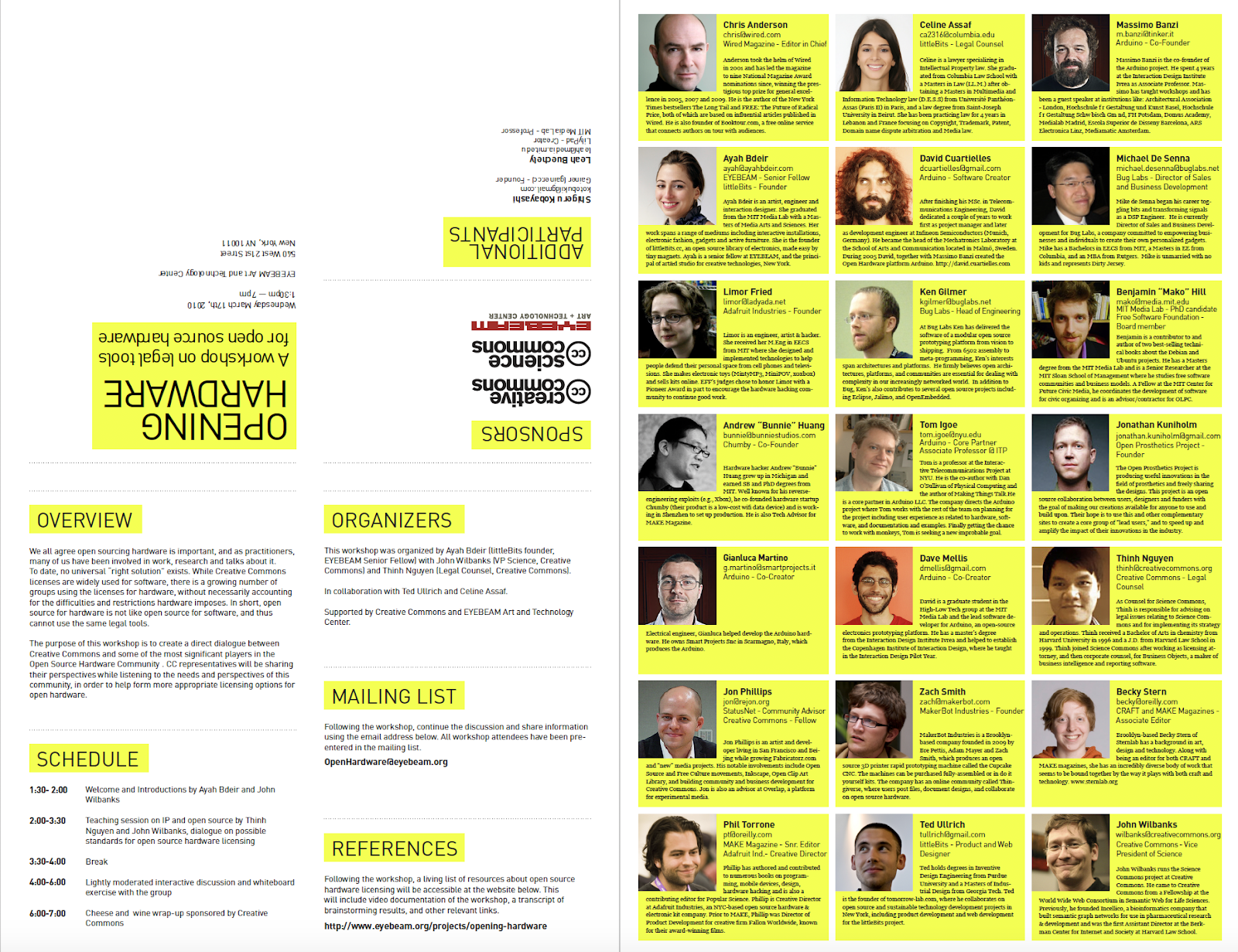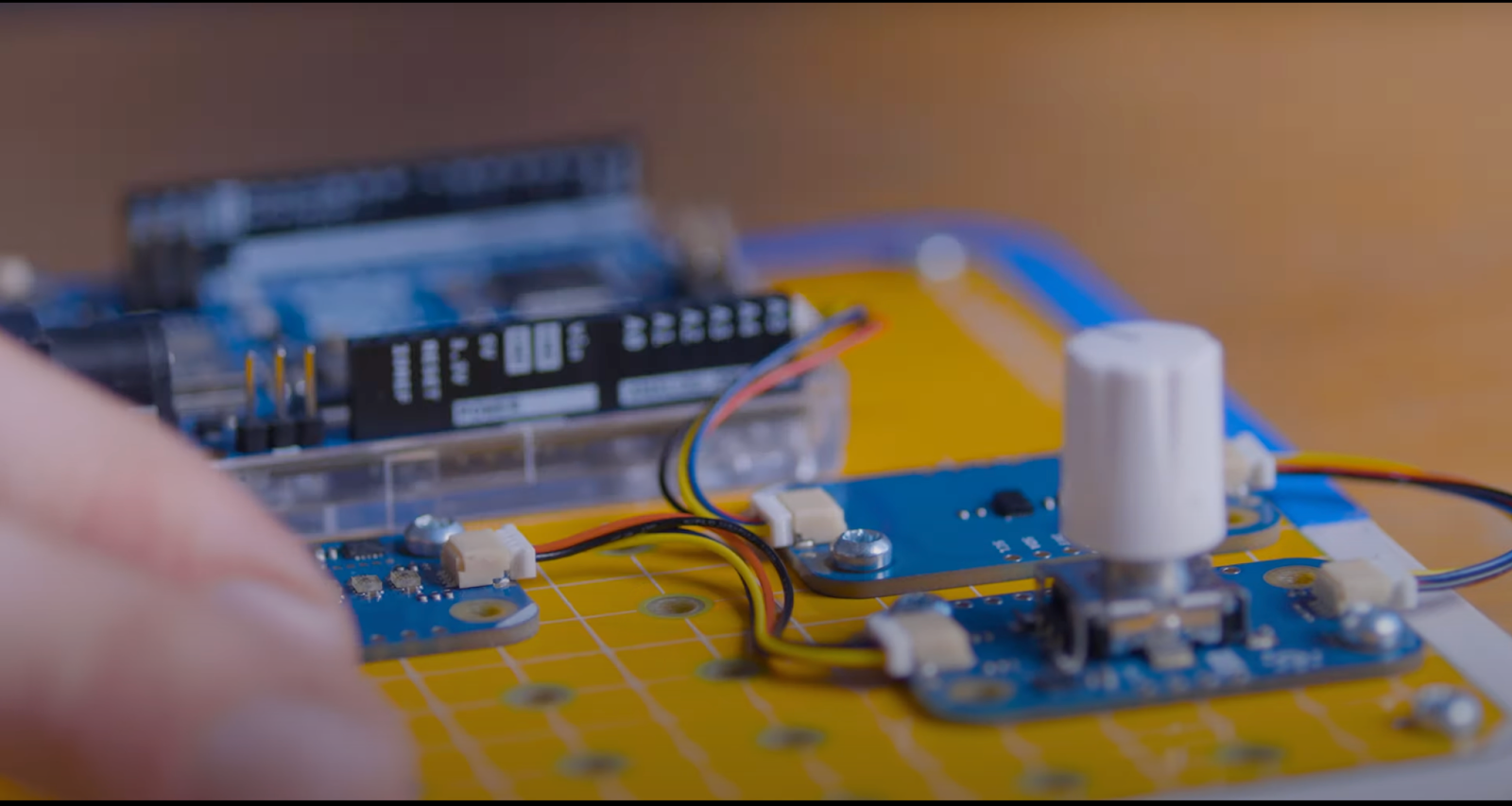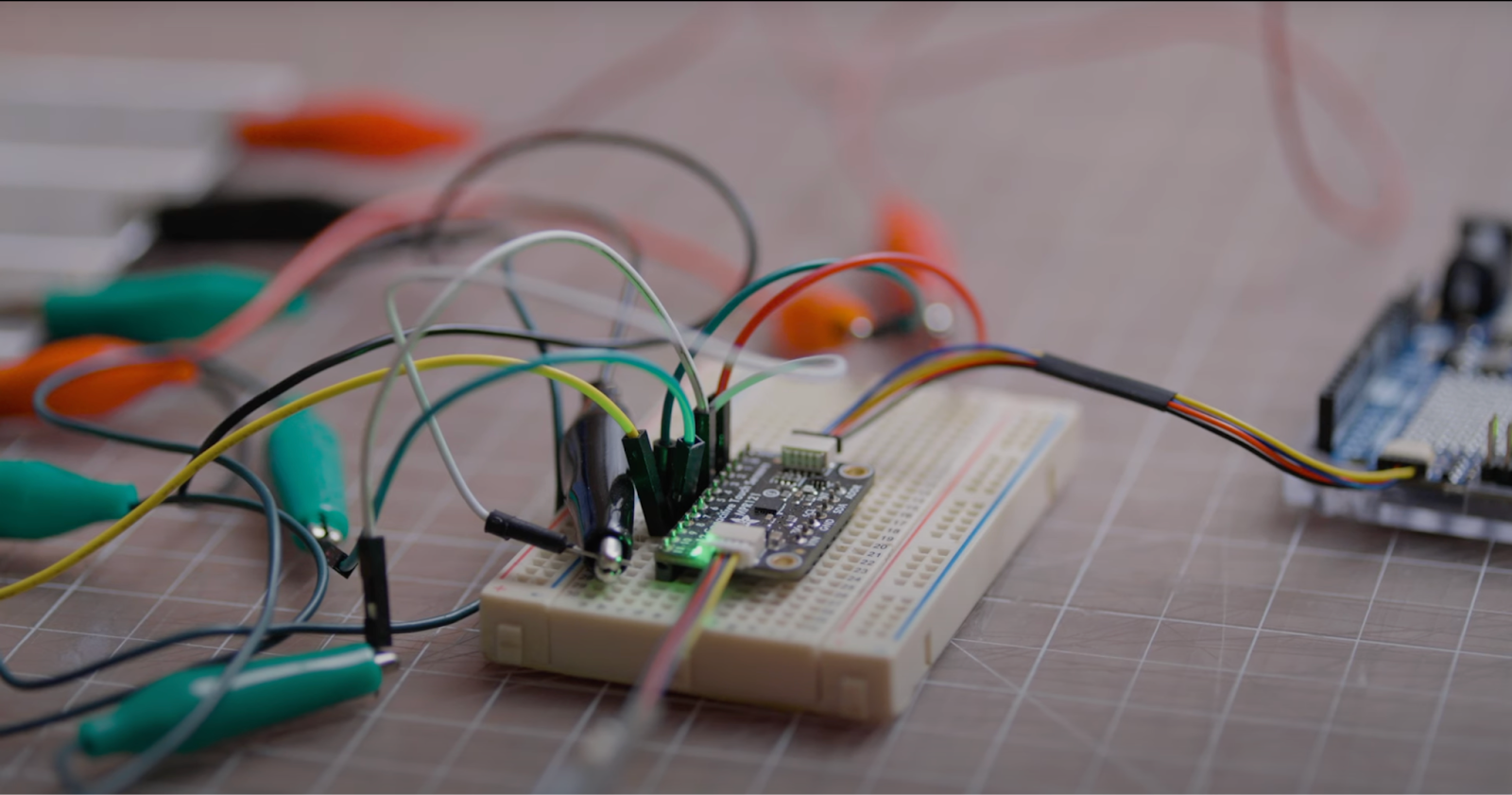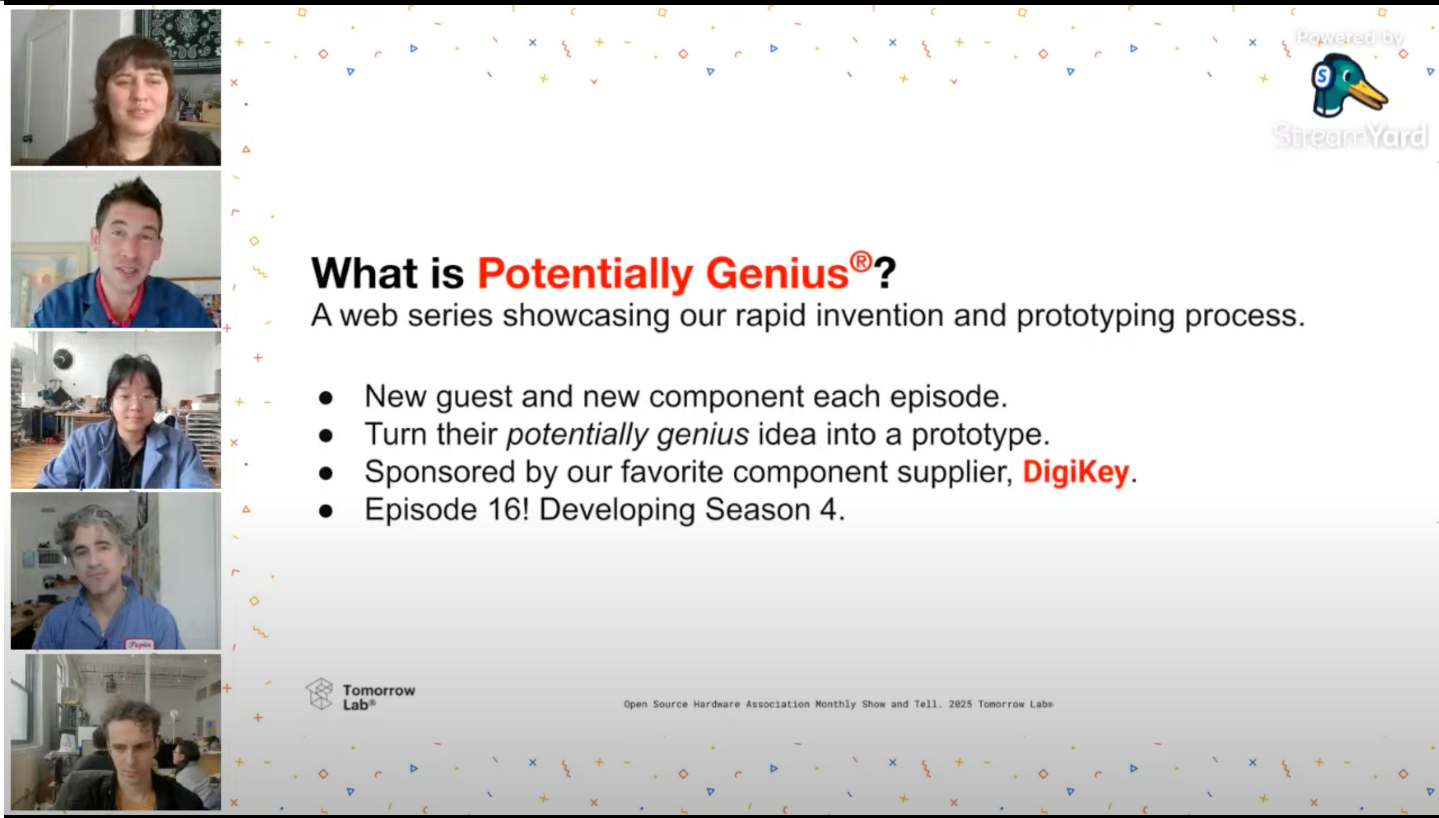A suitcase is meant to hold things—to contain, to enclose and to keep safe. It is the architecture of transit and a boundary between inside and out. But what if a suitcase is not just a vessel for storage, but for iteration? Not just a way to carry things, but to carry forward?

For the recent and final episode of Season 3 of Potentially Genius episode from Tomorrow Lab, we made a Suitcase Synth Modulino using the Arduino Plug and Make Kit. The Suitcase Synth Modulino is a compact synthesizer leveraging the other modulinos from the kit and designed to be taken anywhere. After we built, presented and delivered the episode, we then open-sourced it. The Open Source Hardware Certification was not an afterthought but a statement: this is not a closed object, a finished product or a thing with fixed edges. This is a soft machine, one that bends toward new hands, new modifications and new futures.
What is Open Hardware?
In 2010, a group of artists, engineers, educators, and tinkerers gathered at Eyebeam in New York City for what would become the Open Hardware Summit[1]. Today, the Open Hardware Summit is held annually, bringing together practitioners from across disciplines to discuss the evolving landscape of open-source hardware. The Open Source Hardware Association (OSHWA) maintains a certification system, allowing individuals and organizations to register their projects in a public database, specifying the extent of their openness. Unlike proprietary hardware, which is often designed to conceal its inner workings, certified open hardware is documented, modifiable and legally structured to encourage reuse and adaptation. The certification is very light weighted, and the certifier can choose the level of strictness of copy left[2].

Why Open Hardware?
Larger corporations seem to have created and contributed to an enclosed culture to their hardware developments. Products arrive in sealed casings, designed to “magically work” until they don’t, with “no user-serviceable parts inside.” “Opening this will forfeit your warranty.” These are the languages of product design as control—a system where ownership is never complete, where every device is a contract between the user and the manufacturer, a contract that begins and ends with purchase and not participation.

For many individual practitioners, when modern hardware culture operates in the black-boxed, the obvious answer to the question, “why open-source hardware,” is that open-source shares knowledge and information – which not only supports technology advancement itself but also promotes rethinkings and continuations. More importantly, open source is a rejection of proprietary enclosures and a recognition of the hidden labor embedded in every piece of technology.
Circuits have always been assembled by human hands, whether by Navajo women at Fairchild Semiconductor in the 1970s or by factory workers in Shenzhen today[3]. Yet their labor is unlikely acknowledged as part of the innovation process in the black-boxed product. Open-source hardware resists this erasure, allowing technology to remain adaptable, accessible and participatory, rather than locked behind corporate control.
As much as the ethical reasons are important, the logic of open hardware is inherently more aligned with the ecosystem of hardware development because hardware doesn’t exist in isolation. Components become assemblages, assemblages form circuits, circuits integrate into chips, and chips can be integrated into more hardware systems. In this branching evolution, each layer exists because of the one before it.
When a component gets certification, it often encourages broader adoption in within the ecosystem. Take the MPR121 capacitive touch sensor (OSHWA certification US000407) as an example. The MPR121 breakout board is certified by Adafruit, one of the most significant forces in open-source hardware. We integrated it into the Suitcase Synth for Potentially Genius Ep16. But we weren’t the only ones. José Manuel Mariño Mariño’s MIDI Touch Keyboard (OSHWA certification ES00046) also employs the MPR121, adapting it into a portable MIDI controller for expressive touch-based interaction. As one can imagine, this small branch on MPR121 is only a fraction of the growing hardware community within Open Source Hardware Certification.

Beyond individual components’ ecologies, open-source hardware also empowers creative communities to reimagine technological expression. Developed by Bela, the Trill capacitive touch sensors (OSHWA certification UK000066) are designed for artists and musicians to create customizable, high-resolution touch interfaces. Unlike commercial touch technologies that lock users into predefined gestures and interactions, Trill is open-source and adaptable, allowing users to define their own modes of engagement. It enables new types of musical instruments, responsive installations, and experimental interfaces that wouldn’t exist in a closed system. More importantly, Trill demonstrates that open-source hardware isn’t just about function—it’s about creative agency. By giving users control over how a tool responds, rather than just what it does, Trill exemplifies how openness fosters not just technical innovation, but entirely new forms of expression.
Open Hardware and Tomorrow Lab’s Design
However, when it comes to design consulting firms like Tomorrow Lab, there is the contradiction – open hardware does not easily fit into a consulting business model. As consulting firms do not sell products directly, they sell expertise, innovation, and intellectual property development. Clients rarely come to open-source what they have built – they come to own it, patent it and protect it. The logic of consulting is often tied to proprietary design, IP protection, and differentiation—a logic that seems to stand in opposition to openness. Open hardware, at first glance, exists in tension with this reality.
But for Tomorrow Lab, choosing open-source is not just an ideological gesture; it is a practice that actively shapes design itself. Firstly, open-source hardware does not undermine hardware expertise—it reveals expertise and unique processes. The recent synthesizer episode of Potentially Genius is a perfect example. By working on an open-source project, we were able to publicly share our creative and technical process—an approach Tomorrow Lab calls Holistic Innovation, which our team is deeply proud of. This kind of transparency is often impossible in traditional consulting work, where the labor of problem-solving, prototyping and iteration remains obscured. But by contributing to open-source projects when possible, we create a space where knowledge is not just exchanged, but built upon.
Openness also functions as an invitation—it allows for collaboration, critique and iteration. Design firms rarely work in isolation; they operate within networks of innovation, where knowledge circulates through shared problem-solving. The Potentially Genius web series is sponsored by one of our favorite suppliers DigiKey – who is an active participant in the open hardware community. During the certification process of Suitcase synth, our partner at DigiKey actually pointed out that our documentation was missing one 3D model file to complete the build, so we were able to fix the oversight and completed the documentation for this release. This small collaborative effort showcased that the act of sharing does not dilute expertise—it reinforces expertise, ensuring that a design is not just completed, but continually refined through collective input.
Openness continually inspires our designs at Tomorrow Lab. In every episode of Potentially Genius, we are connected with hardware experts who are eager to share their creations. These exchanges do not just introduce us to new technologies and components, they make visible the invisible decisions, insights and refinements that go into every open-source project. For the Suitcase Synth Modulino, this process became particularly clear. Even though the Plug and Make Kit itself is not Open Hardware Certified, Alessandro Ranellucci shared invaluable design insights with us throughout Arduino’s development process. When we finally showed him the completed design, his reaction encapsulated something fundamental about open hardware: the fulfillment of seeing a creation evolve beyond its original intent. The joy was not just in recognition, but in the continuity of design itself—the knowledge that his work did not stop with him. I remember being in my blue suit at Tomorrow Lab in Brooklyn, eagerly showing off the creation to Ranellucci in Rome, thinking ‘I cannot wait when our Suitcase Synth Modulino and more of our creations get iterated on by someone else’. The act of making something public does not forfeit control—it expands the space in which ideas can evolve through transparency that invites collaborations.

On February 21st, Tomorrow Lab’s team presented at the Open Hardware Monthly Show & Tell, discussing the creation of the Suitcase Synth Modulino and the role of open hardware within a design consultancy. It was not a product launch, nor a workshop or case study in proprietary innovation, but something softer. A moment of exchange and an offering to a community where knowledge moves freely. For a consulting firm, open-source hardware obviously does not replace proprietary client work, nor does it exist in opposition to it. Rather, it expands the space of design itself, softening the boundaries between expertise and accessibility, authorship and adaptation, ownership and continuation. Open-source hardware does not diminish innovation; it ensures that it does not end.
To open something is to acknowledge that the design is ever truly complete. It is to create things that do not resist modification but encourages interations–machines that bend toward new hands, new modifications and new futures. Softness is not weakness. It is what allows something to travel, like a suitcase filled with creativity and ideas.
- Ted Ullrich, our founder at Tomorrow Lab, also contributed to the inaugural summit. ↩︎
- https://certification.oshwa.org/ ↩︎
- Lisa Nakamura, Indigenous Circuits: Navajo Women and the Racialization of Early Electronic Manufacture, American Quarterly 66, no. 4 (December 2014): 919–941, doi: 10.1353/aq.2014.0070. ↩︎
[This text is copy edited using large language models.]
